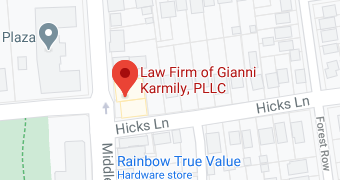Battered woman syndrome (BWS) is a psychological condition often developed by domestic violence victims. Nassau County, Long Island criminal defense attorney Gianni Karmily understands that battered woman syndrome is critical in self-defense cases involving family violence.
Gianni Karmily, Nassau County, Long Island domestic violence attorney, explains the battered spouse defense and how past abuse, especially if prolonged, can impact a legal defense. If you’re facing criminal charges in the Nassau County, Long Island area, an experienced domestic violence lawyer at the Law Firm of Gianni Karmily is ready to represent you. To schedule a case evaluation, call (516) 630-3405 for our office in Great Neck or (516) 614-4228 for our location in Hempstead.
What is Intimate Partner Violence?
New York State law defines an intimate partner as a family or household member. But this definition also includes other close relationships.
Intimate partner violence can be between people:
- who legally married or divorced
- that have a child in common, including adopted children
- related by marriage
- related by blood
- who are unrelated but live or have lived together
- who were in an intimate partner relationship (current or former)
Intimate partner violence can occur even if you don’t live with an abusive partner, don’t have a sexual relationship, or have ended the relationship.
Factors the court may consider for determining an “intimate partner relationship” include the nature of the relationship, the amount of time spent together, and the length of the relationship.
A casual friend or coworker is not an intimate partner under New York State law.
Intimate partner violence occurs when an abusive partner uses abusive behavior to gain or maintain power and control over the other intimate partner. When we think of the term “abusive partner,” we tend to think of abusive spouses or an abusive husband. However, any of the previously mentioned examples could legally constitute intimate partner violence under New York State law.
Examples of intimate partner abuse include acts of physical violence, sexual violence, threats of physical or sexual violence, emotional abuse, and controlling behaviors.
What is Battered Woman Syndrome (BWS)?
Battered woman syndrome was defined by Lenore Walker, describing a battered woman as “a woman, 18 years of age or over, who is or has been in an intimate relationship with a man who repeatedly subjects or subjected her to forceful physical and psychological abuse.”
Walker bases this theory of battered woman syndrome on research involving learned helplessness in animals, confirming the theory by studying 400 battered women from 1978 to 1981.
While Dr. Walker referred to battered woman syndrome (BWS) is a psychological condition and sub-type of posttraumatic stress disorder, that develops in domestic violence victims in instances of prolonged abuse, this view is not supported by the American Psychiatric Association, as battered woman syndrome is excluded from the Diagnostic and Statistical Manual of Mental Disorders.
While it is very likely that battered women with a history of intimate partner abuse could certainly meet the criteria for post-traumatic stress disorder, the experience of a traumatic event is not sufficient enough for a post-traumatic stress disorder diagnosis.
Unlike PTSD, the battered woman syndrome shifts to include disrupted healthy relationships because of isolation, power and control by the abusive partner, distorted body image, as well as health and sexual issues.
However, a battering relationship does not only pertain to abusive men and abused women.
Battered Person Syndrome
Historically, abused women who killed their abusive partner would be labeled as having battered woman syndrome (BWS), the term then used to describe women who reacted to domestic violence by killing an abusive partner. While termed “battered woman syndrome,” men can also fall victim to an abusive partner. In this case, the terms are “battered person syndrome” or “battered spouse syndrome,” referring to a victim of an abusive relationship.
The battered person syndrome is characterized as severe psychological distress resulting from sustained and serious domestic violence, including physical, emotional, sexual, and psychological abuse.
Abused women and men often experience feelings of helplessness, a state of constant fear, and a perceived inability to escape a battering relationship. Battered woman syndrome can lead to significant behavioral changes and mental disorders, like depression, anxiety, and post-traumatic stress disorder (PTSD).
Battered Person Syndrome Background
Throughout history, societal norms and laws often positioned women as subordinate to men. In Western civilization, historical legislation sanctioned men’s authority over women, including physical discipline.
For example, Roman law allowed husbands to exert physical force on their wives as a form of discipline. The “rule of thumb” adopted by early American states, permitted a husband to discipline his wife with a rod no thicker than his thumb, ironically intended as a protective measure for the battered wife. Marital rape was not recognized legally across the United States until July 1993, reflecting the denial of a wife’s autonomy over her body. It wasn’t until the early 20th century that significant legal reforms began to classify such acts of violence as assault, reflecting a slow but growing recognition of women’s rights and autonomy.
The battered woman syndrome was a theory developed in the 1970s that has now become closely associated with Post Traumatic Stress Disorder (PTSD) symptoms. Battered woman defense or battered spouse defense has been used in criminal cases where a battered woman kills her abuser.
34% of all female victims of murder and nonnegligent manslaughter were killed by intimate partner violence.
Battered woman syndrome helps to explain why many battered women stay in abusive relationships and do not seek assistance for their abusive relationships. The battered woman syndrome also explains why many women who are domestic violence victims have violently attacked their abusers, resulting in criminal charges that can lead to unfair sentencing. These battered women act with a firm belief they must kill their abuser for self-defense or self-preservation.
The battered woman syndrome has been used as a legal defense strategy to justify an array of behaviors, from self-defense and provocation to temporary insanity and diminished responsibility.
The case of Francine Hughes in 1977 marks one of the earliest criminal cases to use the battered woman defense strategy. Hughes was a young housewife, married to an abusive husband who had violently and repeatedly physically and sexually abused her. In March of 1977, after enduring domestic violence for over 13 years, Hughes set her husband’s bed on fire while he was sleeping. She was charged with first-degree murder. Following an appeal that included expert witness testimony, Hughes was found not guilty because of temporary insanity.
Battered Woman Syndrome Stages
The researcher hypothesized that a battering relationship occurred as a cycle:
- tension-building phase
- acute battering phase
- reconciliation phase
Why Battered Women Stay in Abusive Relationships
Contrary to popular opinion, battered women typically can’t “just leave” an abusive relationship. Many women remain trapped in abusive relationships for many complex reasons.
Despite years of domestic violence, most battered women stay in abusive relationships for months, years, or decades. This is because domestic violence comes and goes in a constant cycle: the tension slowly builds, the woman is abused, and then the abusive partner apologizes and promises things will be better. Many women wait for their abuser’s promises to come true.
Battered women stay in abusive relationships because many of them don’t have the resources to escape and are completely controlled by the abusive partner. Children further complicate the situation. Battered women may not want to take their child away from their father due to guilt.
Warning Signs of Battered Woman Syndrome
If you suspect a loved one is a victim of battered woman syndrome, several warning signs may indicate they’re suffering from domestic abuse.
- Fear and Anxiety
- Low Self-Esteem
- Depression
- Social Withdrawal
- Stockholm Syndrome
- Guilt and Shame
- Physical Symptoms
- Hypervigilance
- Changed Behavior
- Denial
How Does the Reasonable Person Standard Apply to Battered Women?
While Francine Hughes is seen as a landmark for the battered woman syndrome defense, she premised her self-defense case on the grounds of temporary insanity.
In the mid 1970’s, the old ideas about battered women and self-defense in the criminal justice system were challenged with the Supreme Court case of Yvonne Wanrow. Wanrow appealed a murder conviction, stating that the trial court had instructed jury members on the issue of the self-defense claim using masculine gender to explain the justification and use of excessive force in self-defense. The use of masculine gender by the trial court implicitly advised jury members to use a male standard to assess a woman’s conduct.
It might be surprising, but significant progress was made when the terms “her” and “she” were used instead of “he” and “him” in the trial court when evaluating a woman’s reasonable person standard in the use of self-defense. However, this is precisely what occurred.
Women’s rights advocates argue that a woman’s perception of danger differs from a man’s. Therefore, to better protect women, the actions of battered women should be judged using a different standard. A reasonable battered woman will rarely act the same as a reasonable person in self-defense cases.
Battered Woman Syndrome Defense
In the criminal justice system, battered woman syndrome has become a defense strategy used by attorneys representing those who have committed violent acts against their abusers.
The American Psychiatric Association conceptualizes battered woman syndrome as the development of a set of personality attributes stemming from ongoing abuse that renders victims more able to survive any physical injury in abusive relationships but less able to escape them.
Three components of battered woman syndrome include behavior brought on by victimization, learned helplessness behavior, and coping behaviors that are self-destructive. Expert testimony during criminal trials should focus on the impact of violence and the battered woman’s perception of threat.
Many legal experts argue that the battered woman defense is not a strong legal defense strategy in and of itself. However, battered woman syndrome may legally constitute the following legal defense strategies. We’ll outline the specific legal defense strategies commonly used by the experienced attorneys at the Law Firm of Gianni Karmily within the overarching theme of battered woman defense.
BWS Defense: Provocation
A provocation is an act, series of actions, or words spoken that would cause a reasonable person (and does cause the accused) a sudden and temporary loss of control. This “passion” can cause the accused to temporarily not master his or her mind.
The Journal of Forensic Psychiatry explains that in criminal cases involving murder, psychiatric evidence can be allowed if it helps explain how the defendant’s unique characteristics influenced their perception of provocation. This evidence is particularly important in cases where the defendant claims they were provoked to commit the crime.
For example, in cases involving battered person or battered spouse syndrome, where the defendant has been a victim of long-term physical violence, psychiatric evidence and expert testimony can be crucial.
These criminal cases often require a detailed look at the past abuse, the effects on the abused women or men, the impact of any substance use, and a clear connection between the defendant’s reaction and the provocation they experienced.
Provocation as a legal defense strategy recognizes that the psychological impact of long-term abuse can lead to a state where the victim perceives an imminent threat, even if it might not be immediately obvious to an outside observer.
BWS Defense: Self-Defense
Self-defense as a legal defense is usually only successful when the battered woman uses a proportionate amount of violence in response to domestic violence. For example, a self-defense claim may be most successful in a situation where a battered woman was directly provoked and had an intense fear for her life. If the abused woman was not provoked but still killed her partner, the defense may not be successful, despite the empirical findings of Dr. Walker.
A self-defense case is grounded in the assertion that the victim believed they were in imminent danger and that their response was necessary to protect themselves from immediate harm.
In applying the battered woman defense strategy, an experienced criminal defense lawyer will typically present evidence of the history and severity of domestic violence to establish a pattern that justifies the victim’s perception of an immediate threat.
BWS Defense as a Temporary Insanity Defense
A temporary insanity defense acknowledges the psychological impact prolonged domestic violence can have, potentially leading to conditions such as posttraumatic stress disorder, depression, or other mental disorders that can affect the judgment and perception of battered women.
Battered Spouse Defense
In New York State, the battered spouse defense is a critical legal strategy employed in criminal cases involving abusive spouses where the defendant has been subjected to continuous abuse. This defense centers on the concept of battered spouse syndrome, a psychological condition resulting from prolonged exposure to domestic violence, which the defense argues influenced the defendant’s actions.
By invoking the battered spouse defense, criminal defense lawyer Gianni Karmily illustrates that the actions taken by the defendant were a direct result of suffering from battered spouse syndrome, underlining a perceived necessity for self-defense or to prevent further abuse or physical violence.
The successful application of the battered spouse defense in New York requires demonstrating the presence of battered spouse syndrome through detailed evidence, including the expert testimony of psychological experts familiar with the syndrome’s impact on a person’s mental state and decision-making.
The battered spouse defense, by focusing on battered spouse syndrome, seeks to contextualize the defendant’s actions within the framework of their abuse experiences, regardless of whether the abusive relationship came from an abusive man or woman, emphasizing the role of battered spouse syndrome in shaping their response to the threat posed by their abuser.
Why Battered Woman Syndrome is Questioned as a Legal Defense
Legal experts question battered woman syndrome as a legal defense because:
- Evidence of past abuse is generally not admissible in New York criminal trials unless there are extenuating circumstances (Sec. 4. 21), but most states do allow for evidence of previous domestic violence (orders of protection, police reports, witness statements, etc.) to be used as evidence.
- Battered women act and think differently in their abusive relationships.
- When you apply the reasonable person standard, battered women have rational reasons for believing their lives are in danger. A specific instance of domestic violence doesn’t have to occur for a battered woman to feel like she or her children’s lives are at stake. For example, “provocation” could be “a look” from an abusive partner that causes the battered woman to believe she is in danger because she has seen that specific “look” before suffering abuse in the past.
- The battered woman defense often doesn’t allow other reasons for homicide outside ongoing domestic violence. It’s not unheard of for some domestic violence victims to kill out of jealousy or greed, for example.
- It’s difficult to prove intimate partner abuse in court. Domestic violence typically happens behind closed doors, so in many cases, an abused woman is the only witness. Many women don’t tell friends or family about the battering relationship or family violence out of fear of punishment later. Even if the abusive relationship reaches the potential for homicide, there still may be no evidence a violent relationship existed despite the battered woman exhibiting PTSD symptoms.
- The BWS defense can potentially paint abused women as females who are merely passive victims and not the resourceful survivors they are.
Why You Need an Experienced Criminal Defense Attorney on Your Side
Facing criminal charges in a case involving battered woman syndrome requires the expertise of a seasoned criminal defense attorney like Gianni Karmily. These legal cases demand a deep understanding of the legal and psychological aspects involved.
At the Law Firm of Gianni Karmily, your criminal defense attorney can navigate the complexities of such cases with compassion and proficiency. Attorney Karmily possesses the necessary skills to interpret psychological evidence and craft a legal defense strategy that accurately represents the impact of prolonged abuse on the accused’s actions.
Nassau County, Long Island Domestic Violence Attorney
Whether you’re a battered person who needs an experienced and compassionate defense lawyer or you’ve received a false charge of domestic violence in New York State, domestic violence attorney Gianni Karmily understands the delicacy and urgency of these legal matters. He is committed to providing compassionate, confidential, and robust legal support. You can trust that your case will be handled with the utmost care and professionalism, ensuring your rights are protected and your voice is heard.
To learn more about how Nassau County, Long Island domestic violence attorney Gianni Karmily can help you fight criminal charges, schedule a case evaluation at our law firm. Call (516) 630-3405 for our Great Neck location, or call (516) 614-4228 for our Hempstead office.









